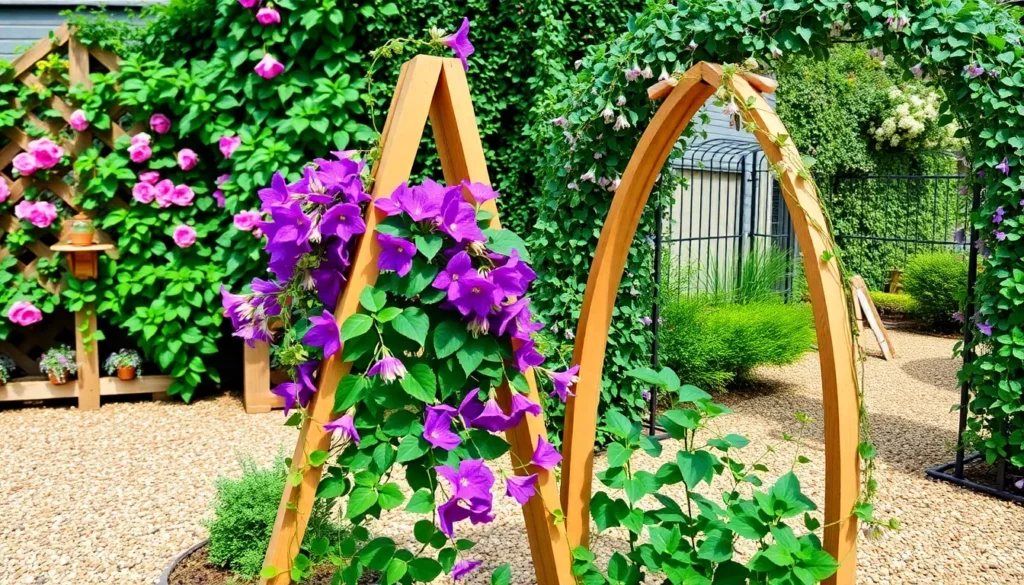Imagine a garden where every climbing plant reaches for the sky, painting your outdoor or indoor space with a tapestry of lush greenery and vibrant blooms. Whether you’re a beginner eager to explore the wonders of vertical gardening or an experienced green thumb looking to elevate your garden’s design, these 12 essential trellis ideas will inspire and equip you with the tools to transform your space into a verdant paradise.
By choosing the right trellis design, you not only support the health and growth of your climbing plants but also add an artistic flair to your garden or home. This guide offers practical insights into selecting and implementing trellis solutions that maximize the beauty and productivity of your climbing plants, ensuring that your gardening efforts are rewarded with breathtaking results. As you delve into these creative ideas, you’ll discover the joy and satisfaction that comes from nurturing your plants to their full potential, confident in your ability to achieve stunning, vertical success.
Choose Sturdy Trellis Materials
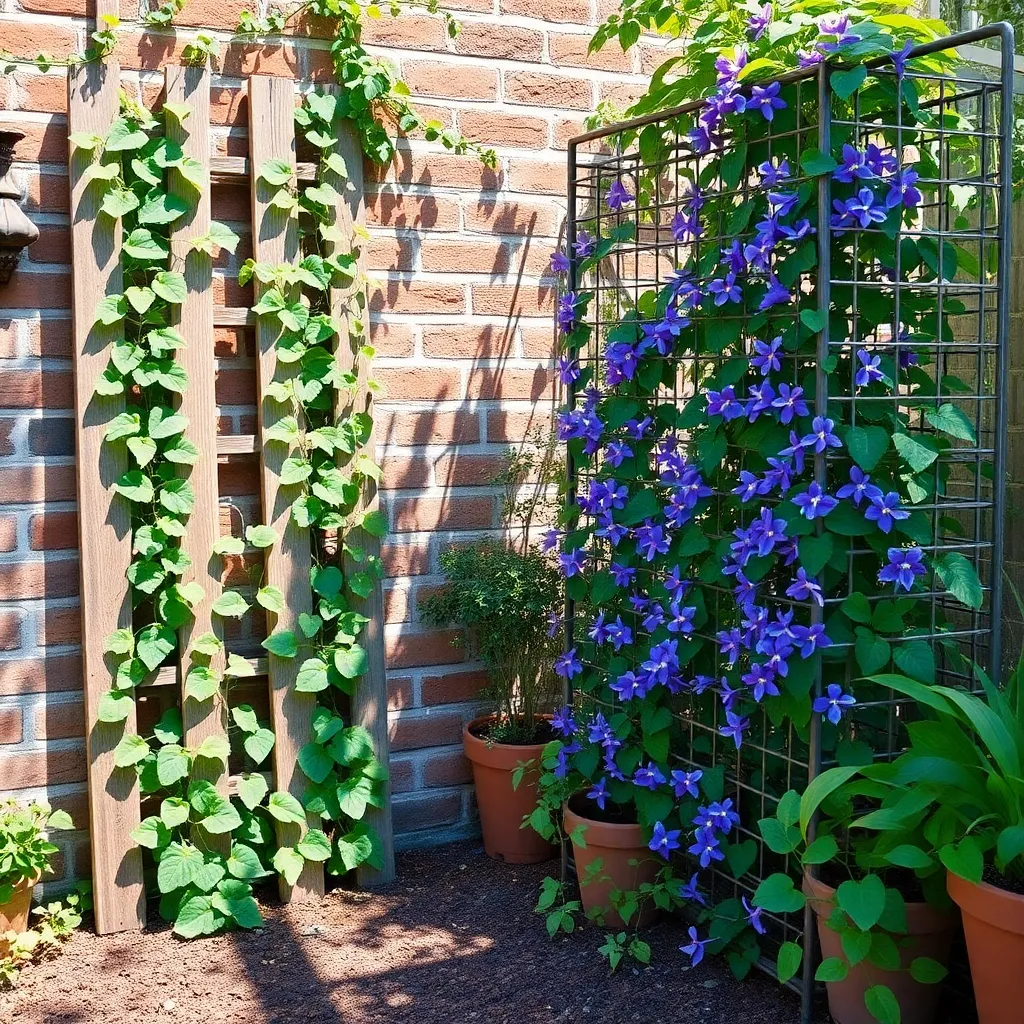
When selecting materials for your trellis, it’s crucial to choose options that can withstand the test of time and the weight of your plants. Consider using sturdy materials such as metal, treated wood, or bamboo which can provide the necessary support for climbers like clematis or roses.
For gardeners in areas with harsh weather, metal trellises offer durability and resistance to decay. Powder-coated steel or wrought iron are excellent choices, as they resist rust and can handle heavy winds, ensuring long-term reliability.
Bamboo is another popular choice for a lightweight yet strong trellis material. Known for its flexibility and natural look, bamboo can be easily cut and shaped, making it ideal for DIY projects or irregular garden spaces.
When constructing a trellis from wood, opt for pressure-treated lumber or cedar, as these materials naturally resist rot and insect damage. Make sure to seal the wood to extend its life and maintain its appearance over time.
Install Trellises Before Planting
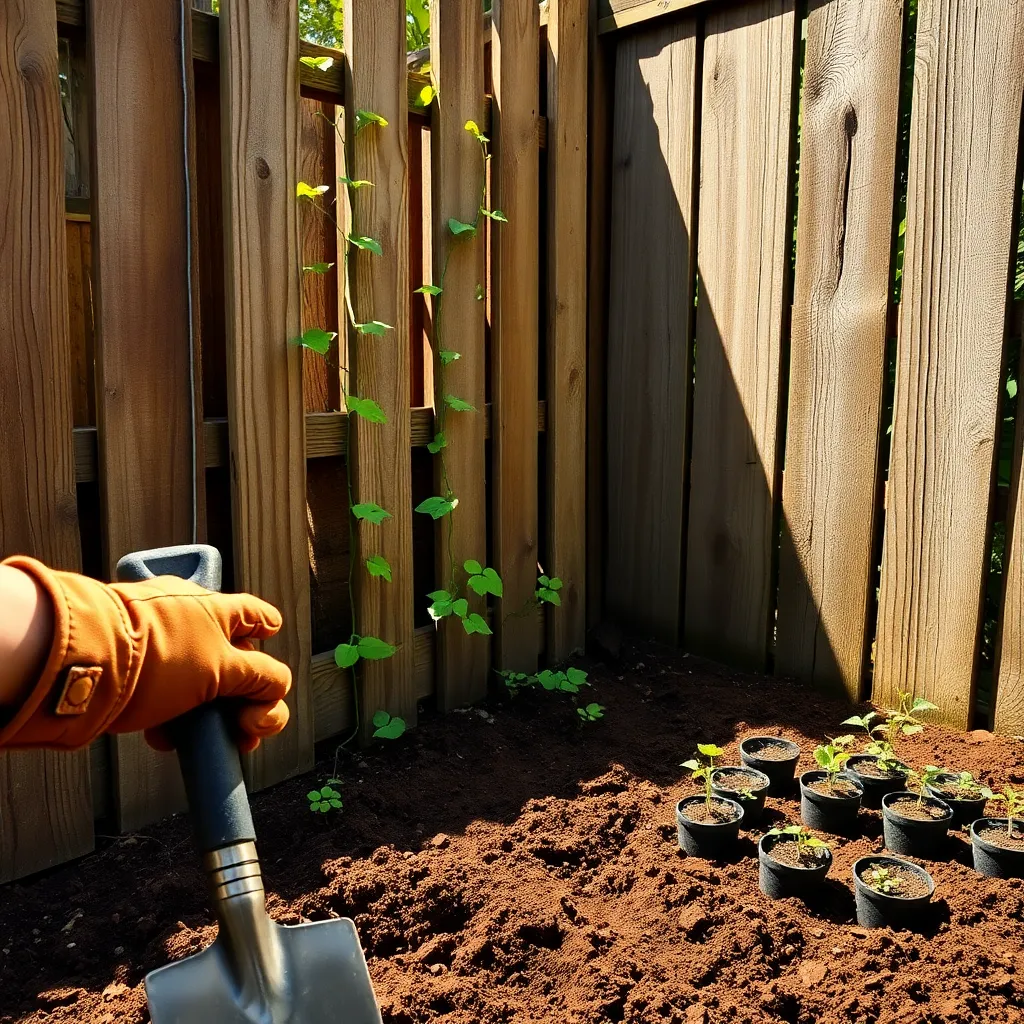
Before planting climbing plants, it’s crucial to install trellises to ensure that your plants have the right support from the start. This approach not only prevents soil disturbance around young roots but also guides plant growth in the desired direction.
When setting up trellises, remember to position them securely in the ground to withstand weather conditions and the weight of mature plants. Use a mallet or heavy-duty stake driver for wooden or metal trellises to ensure they are deeply anchored.
Consider the specific needs of your plants when choosing trellis height and style. For instance, peas and beans thrive on vertical, net-like structures, while roses and clematis often require more robust, fan-shaped trellises.
To maximize plant health and productivity, ensure your trellises allow for proper air circulation and sunlight exposure. This setup helps prevent fungal diseases and encourages lush growth, giving your plants the best chance to flourish.
Position for Optimal Sunlight
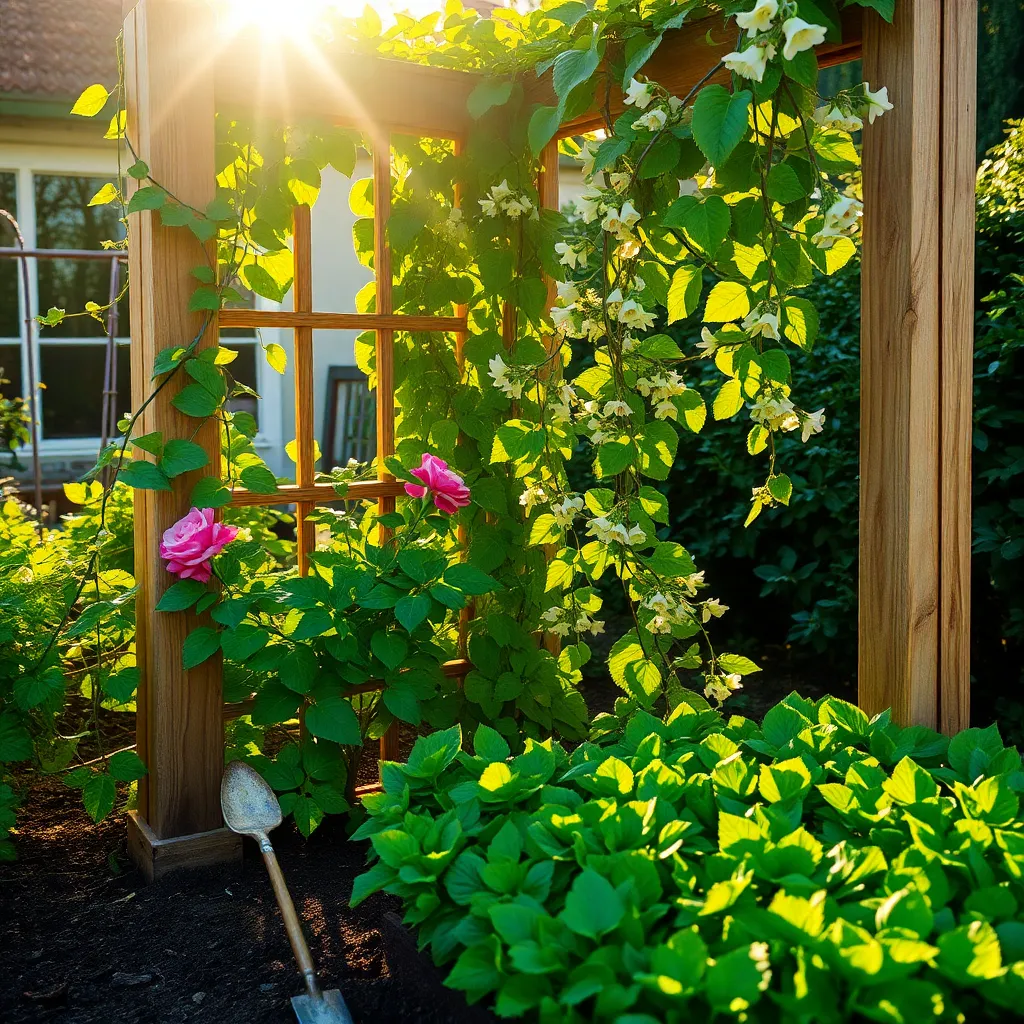
Positioning your trellis for optimal sunlight is crucial for the health of your climbing plants. **Most climbing plants thrive in full sun**, which means they need at least six to eight hours of direct sunlight daily.
When choosing a spot for your trellis, consider the sun’s path throughout the day. **Avoid locations shaded by buildings or large trees**, as this can limit the sunlight your plants receive, affecting their growth and flowering potential.
In the northern hemisphere, a south-facing position is generally ideal because it maximizes sun exposure. **In contrast, gardeners in the southern hemisphere should aim for a north-facing position** to achieve similar results.
For those living in particularly hot climates, providing some afternoon shade can be beneficial. **This prevents heat stress and helps preserve soil moisture**, which is crucial during peak summer months.
Consider the specific needs of your climbing plants, as some may tolerate partial shade. **Plants like clematis can thrive with morning sun and afternoon shade**, making them adaptable to different sunlight conditions.
Ensure that the soil around your trellis is well-drained and enriched with organic matter. **This supports healthy root growth and better water retention**, ensuring your climbing plants stay vigorous and robust throughout their growing season.
Secure Trellis Firmly in Ground
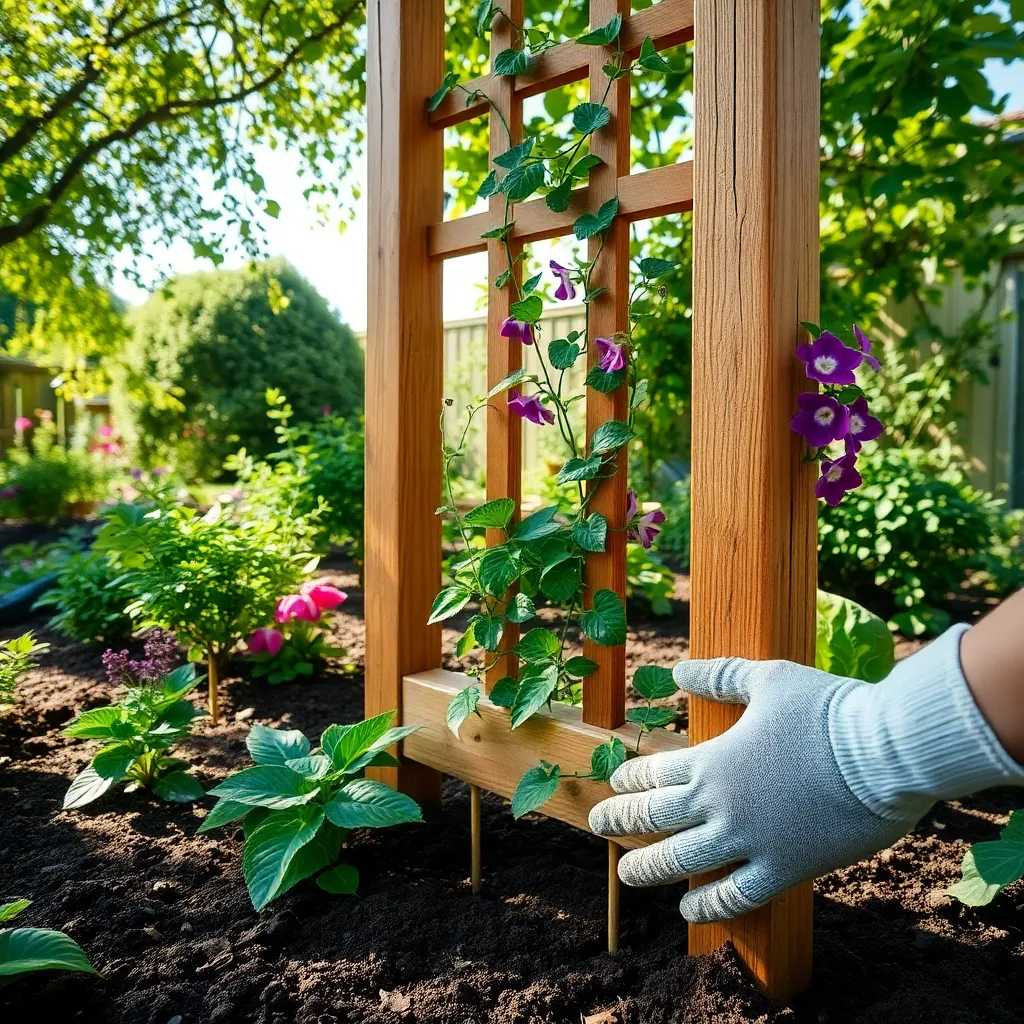
To ensure your trellis provides steadfast support, begin by selecting an appropriate spot with well-drained soil. Use a ground anchor to secure the trellis, especially for larger structures that will bear significant weight from mature plants.
Before installing, consider the type of climbing plant you intend to grow, as some, like wisteria, require robust support. Dig at least 12 inches deep for each anchor point to ensure the trellis remains stable through weather changes and plant growth.
Hammer the stakes or poles of the trellis firmly into the ground using a rubber mallet, which minimizes damage to the material. Check for vertical alignment with a spirit level to maintain a straight and professional installation.
For added stability, particularly in windy areas, consider using guy wires attached to the top of the trellis. Anchor these wires securely into the ground at a 45-degree angle for optimal tension and support.
Match Trellis with Plant Growth
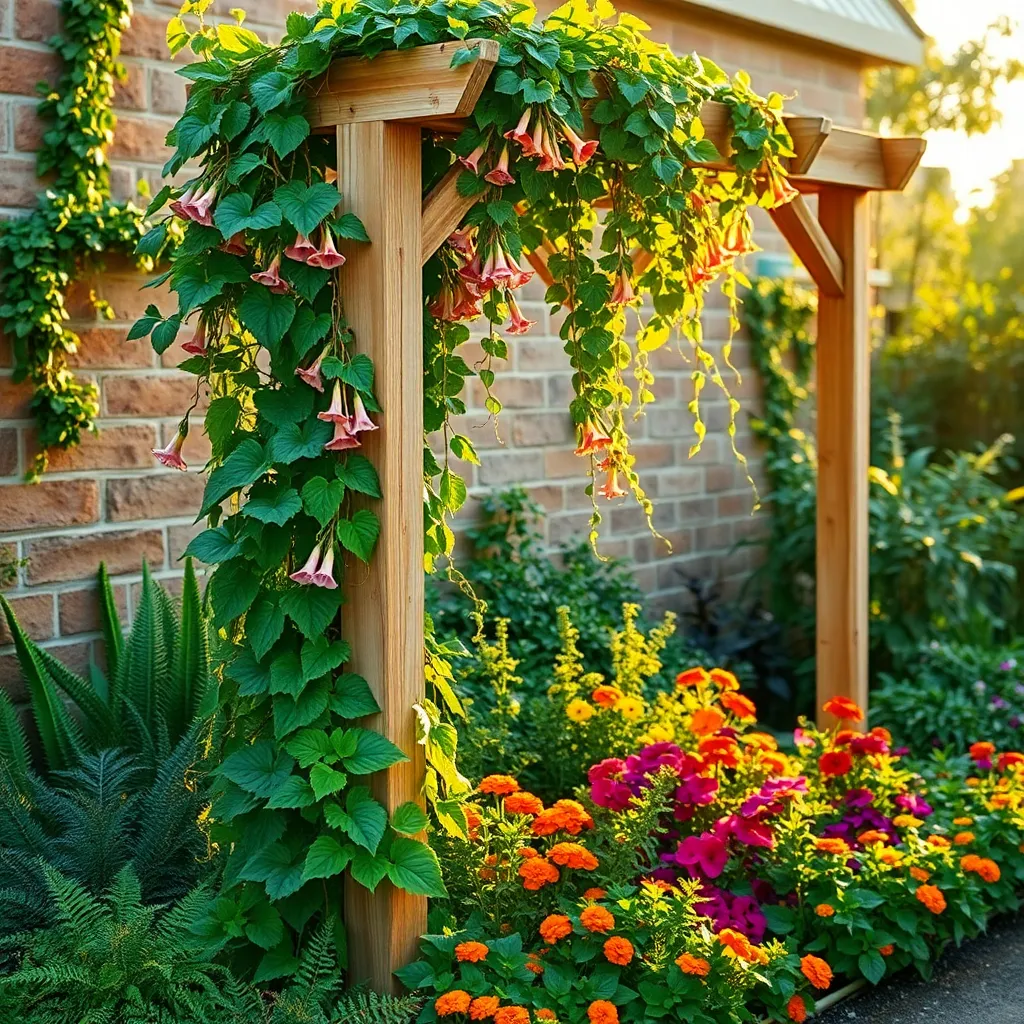
Matching the right trellis with your plant’s growth habit is crucial for success. Different plants have unique climbing techniques, such as twining, tendrils, or scrambling, and each requires a specific type of support to thrive.
For plants that twine, like jasmine or morning glory, a narrow lattice or wire grid works best. These plants wrap their stems around the support, so ensure the trellis provides ample vertical or diagonal pathways for growth.
Plants like peas and clematis use tendrils to climb, making them ideal candidates for a trellis with thin, horizontal bars or mesh. This structure allows their tendrils to grip and pull the plant upwards effectively.
Scrambling plants, such as roses, need a sturdier support system since they rely on thorns or flexible stems to hold onto the trellis. Opt for a robust framework that can bear the weight and provide lateral support for these heavier climbers.
Use Weather-Resistant Finishes
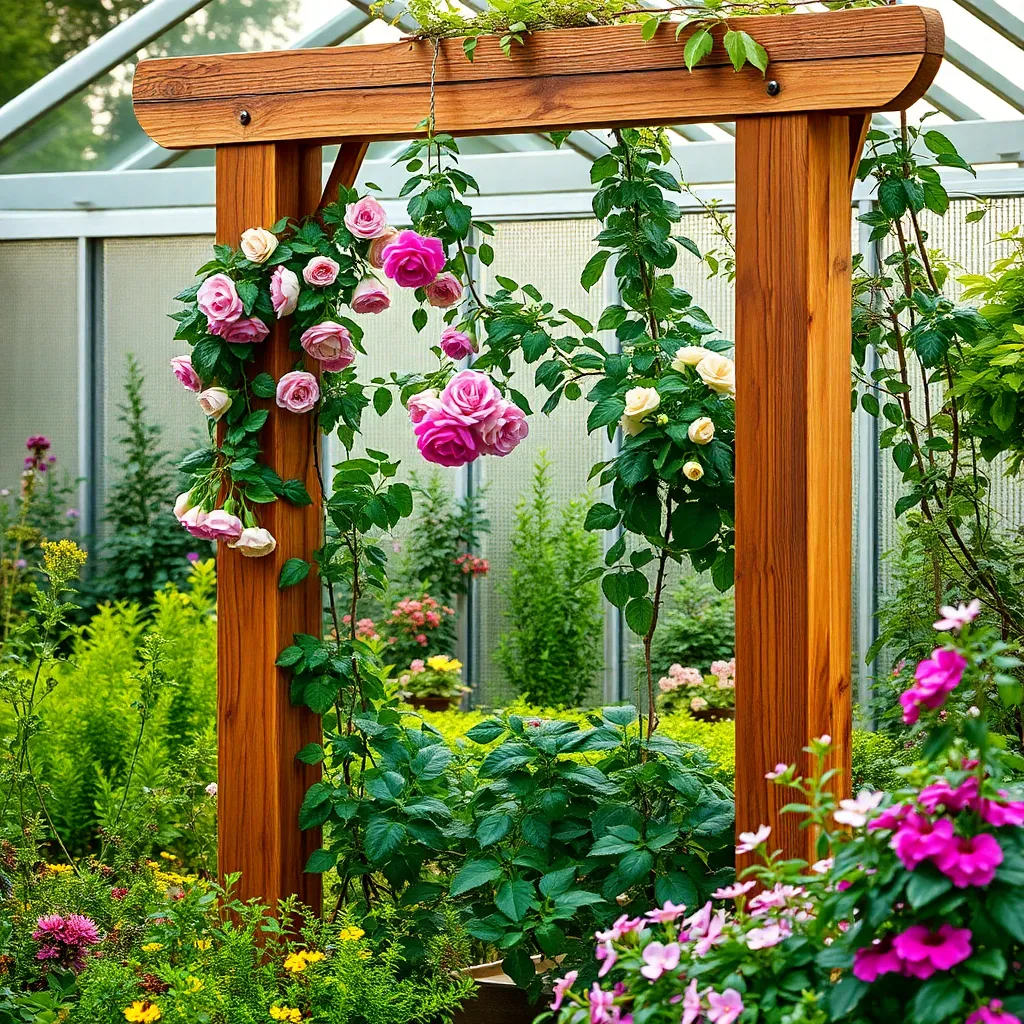
When constructing or buying a trellis, it’s essential to consider using weather-resistant finishes to prolong its life. This ensures your trellis can withstand varying weather conditions, from intense sun to heavy rain, without deteriorating.
A high-quality, weather-resistant finish can protect against rot and insects, which are common issues with untreated wood. For those using metal trellises, consider powder-coating for rust resistance, ensuring your structure remains sturdy and visually appealing over time.
Apply a water-repellent finish to wooden trellises, sealing the surface and reducing moisture absorption. You can use a clear wood preservative for a natural look or a pigmented stain if you wish to add a splash of color to your garden space.
For more advanced gardeners, consider using marine-grade varnish, which offers superior protection against UV rays and water damage. This type of finish is especially useful in coastal areas where salty air can be particularly harsh on garden structures.
Ensure Proper Air Circulation
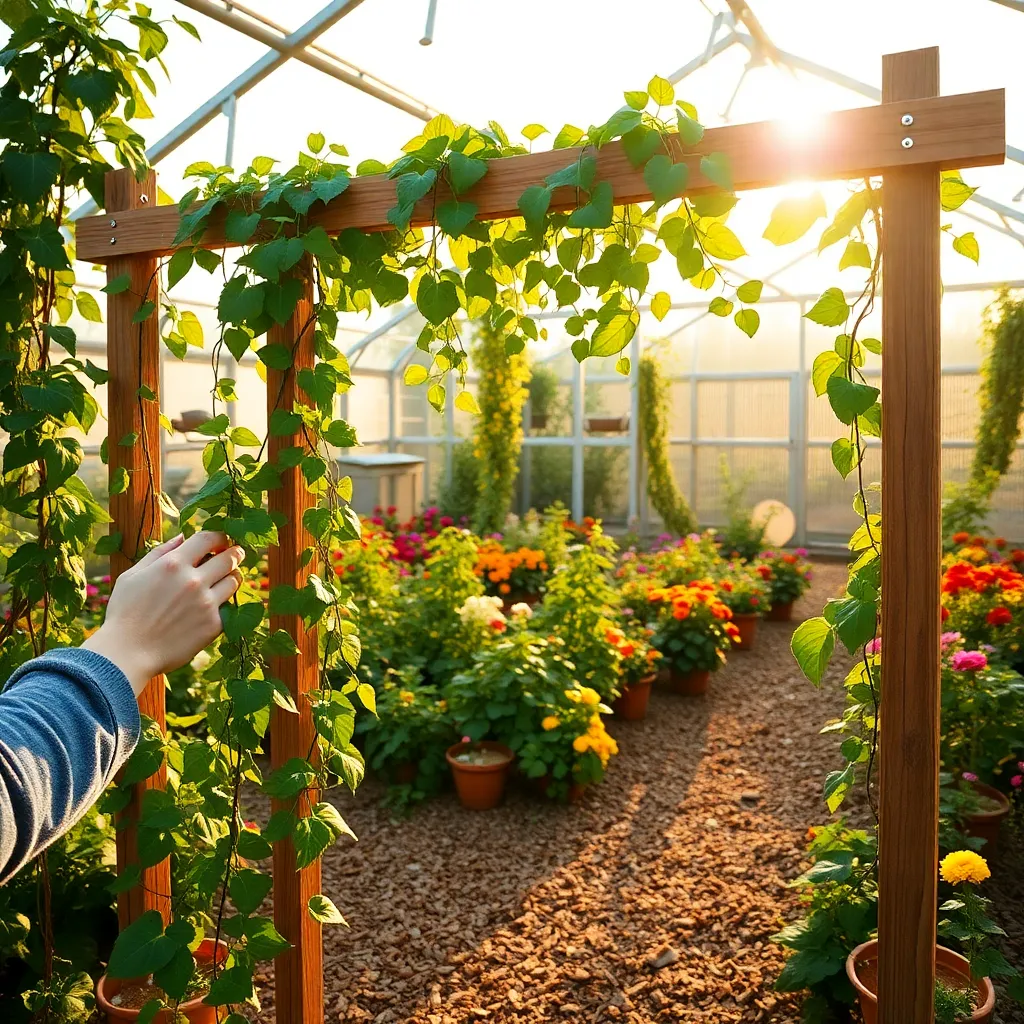
Ensuring proper air circulation is crucial for the healthy growth of climbing plants. Good airflow helps prevent the buildup of moisture that can lead to diseases like powdery mildew and root rot.
Position your trellis in an area where it can catch gentle breezes, which naturally enhance air movement around the plants. Avoid planting climbing plants too closely together, as overcrowding can inhibit airflow and increase humidity around the foliage.
For beginners, it’s essential to trim excess foliage to maintain space between leaves, allowing light and air to penetrate. Advanced gardeners can consider strategic pruning techniques, like thinning out older branches, which can further improve air circulation and encourage vigorous growth.
When selecting plants, choose varieties that are well-suited to your climate, as these will generally require less intervention to maintain healthy airflow. If you’re growing in a humid region, opt for disease-resistant varieties that naturally thrive in such conditions.
Prune Regularly for Health
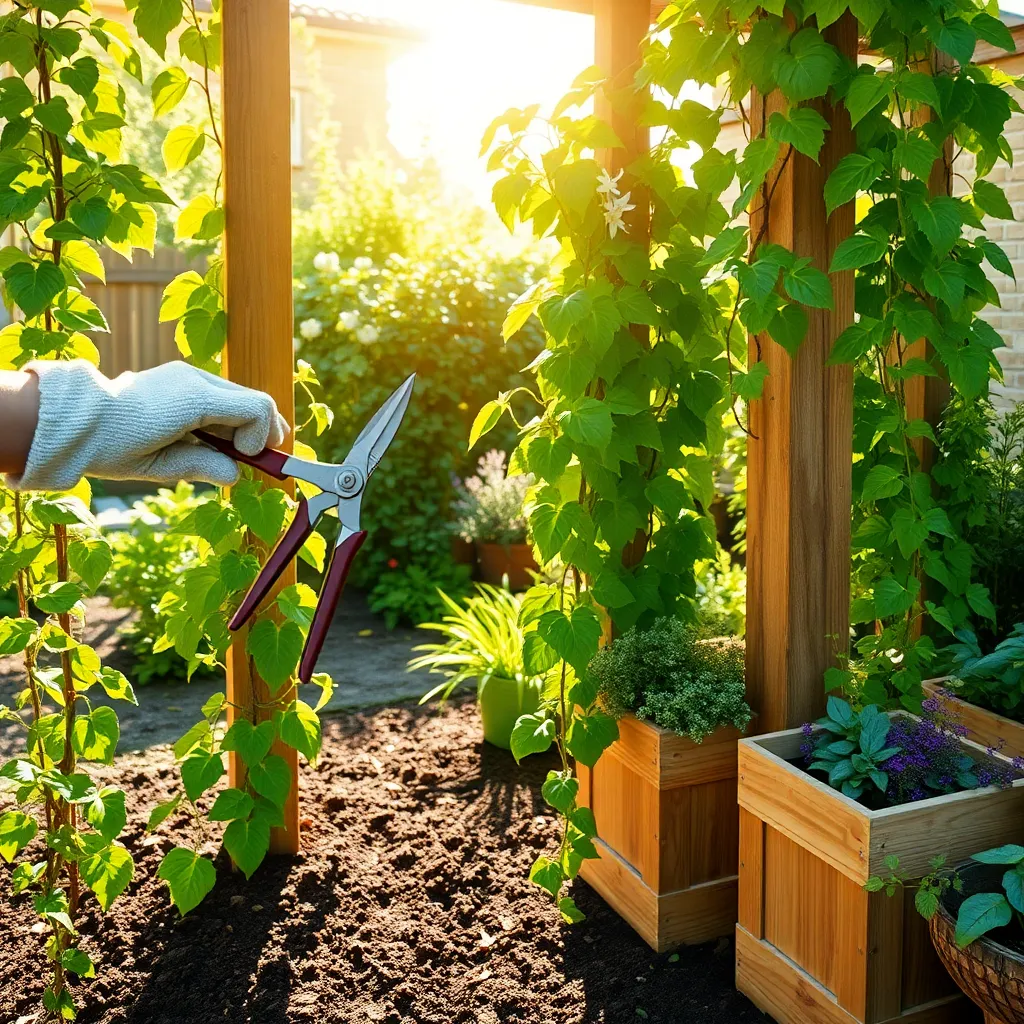
Pruning is a vital practice that keeps your climbing plants healthy and thriving. By regularly removing dead or diseased branches, you can significantly reduce the risk of pest infestations and diseases. Start by identifying any damaged or weak stems, which can hinder the overall growth of your plants.
Focusing on the shape and direction of growth is another critical aspect of pruning. Encouraging your plants to grow in the desired direction will help them make the best use of the trellis. Trim any wayward branches that seem to be growing away from the structure, ensuring your plant remains well-supported and attractive.
Timing is essential when it comes to pruning climbing plants. Most climbers benefit from pruning in late winter or early spring before new growth starts. This timing ensures that you are not cutting off flower buds for the upcoming season, especially for flowering climbers like clematis or wisteria.
For advanced gardeners, consider the specific needs of your plant species. Some climbers, like roses, might require a different pruning approach than vines such as ivy. Research the specific requirements of your climbing plants to ensure you are providing the best care possible. Keeping your pruning tools clean and sharp will also enhance your plant’s health and growth potential.
Train Vines for Even Coverage

Training vines for even coverage is essential to ensure that your trellis looks lush and vibrant. Start by choosing the right type of vine for your trellis, such as clematis or climbing roses, which are known for their ability to cover surfaces well.
Begin training by gently tying the vine to the trellis using soft garden twine or plant ties. Avoid using wire or anything too tight, as this can damage the plant and hinder growth.
Position the vines in a fan shape, spreading them out evenly across the trellis for balanced growth. This method encourages the plant to develop a broader canopy, maximizing its coverage potential.
Regularly check the growth of your vines and adjust their positioning as needed to fill in any gaps. Prune any wayward stems to keep your plant focused on the desired coverage area, and remove any dead or damaged foliage to maintain plant health.
Combine Trellis with Vertical Planters
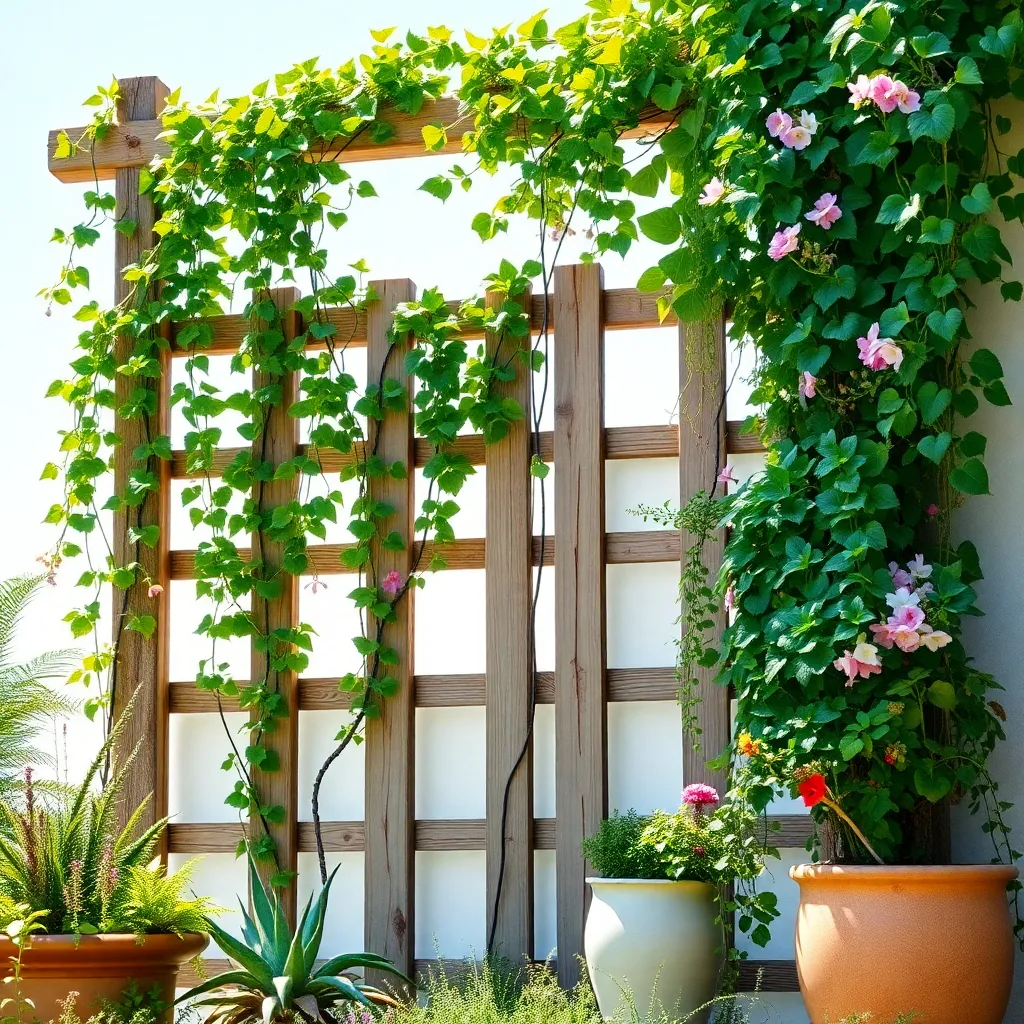
Combining a trellis with vertical planters offers a creative way to maximize space, especially in smaller gardens. This setup allows gardeners to grow a variety of plants, from flowering vines to small vegetables, all in one area.
To start, choose a sturdy trellis that can support the weight of both the planters and the plants. Ensure the trellis is secured firmly to the ground or a wall, as this will prevent any accidents when the plants grow and become heavier.
For the vertical planters, consider using materials like terracotta pots or recycled plastic containers. Drill drainage holes at the bottom of each planter to prevent waterlogging, which is crucial for maintaining healthy root systems.
When selecting plants, opt for a combination of climbing plants and compact varieties for the planters. Climbing plants like morning glories or peas are ideal for the trellis, while herbs or strawberries can thrive in the planters below.
Watering needs will vary based on the plant types, but a general rule is to water thoroughly when the top inch of soil feels dry. Add a slow-release fertilizer to the soil during planting to provide nutrients throughout the growing season.
Advanced gardeners can enhance this setup by integrating a drip irrigation system. This will ensure consistent moisture levels and reduce the manual effort required, especially during dry spells.
Experiment with Decorative Designs
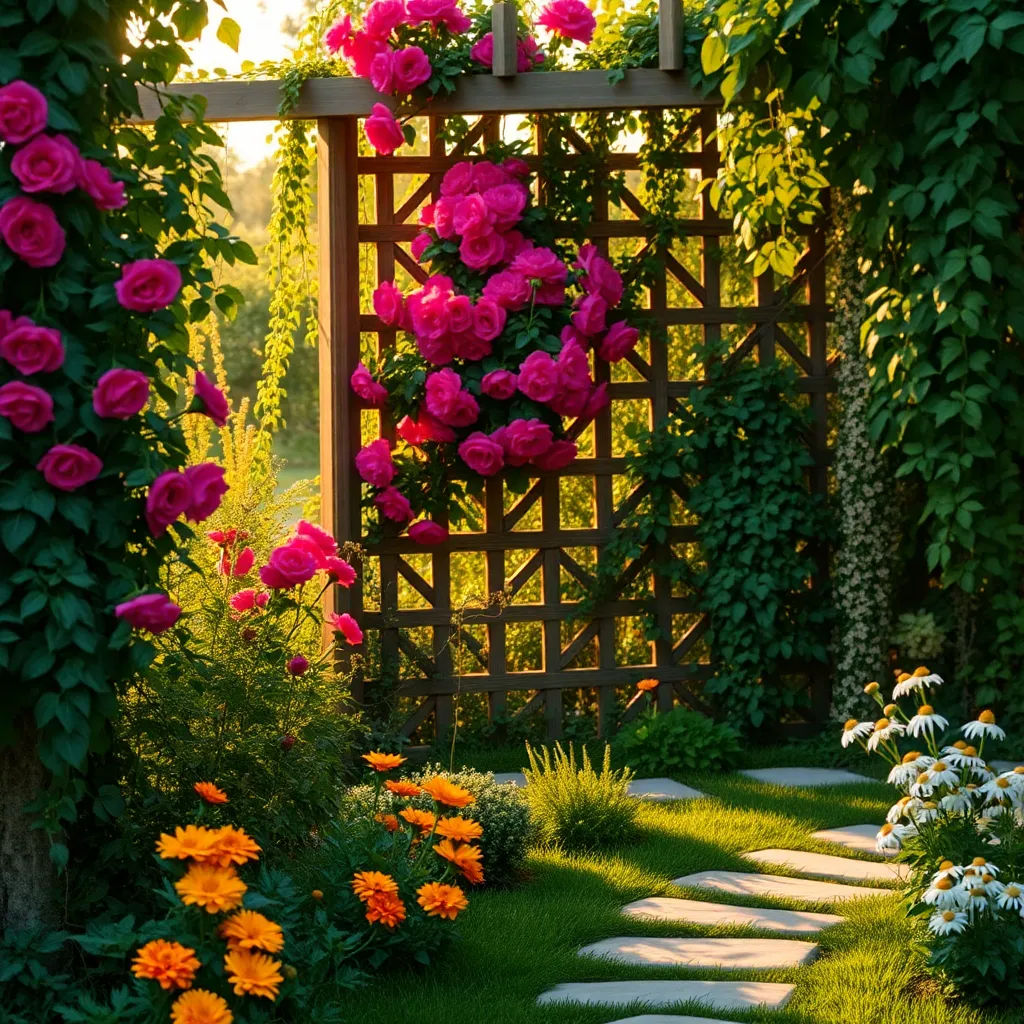
Creating decorative designs with trellises can transform your garden into a living piece of art. Start by experimenting with shapes and patterns, such as fans, diamonds, or spirals, to add visual interest.
Choose plants that are well-suited to the design you envision; for instance, morning glories and sweet peas are excellent for intricate patterns due to their flexible stems. Ensure you provide appropriate support and training techniques to guide their growth along your chosen design.
Consider the use of materials that complement your garden’s aesthetic, such as rustic wood, sleek metal, or even colorful twine for a playful touch. Selecting trellis materials that match your garden theme enhances the overall appearance while supporting plant health.
Regular maintenance is key to keeping your decorative trellis looking its best. Trim and train your plants weekly to maintain the desired shape, and ensure the soil remains fertile and well-drained to support healthy growth.
Rotate Crops Seasonally for Diversity
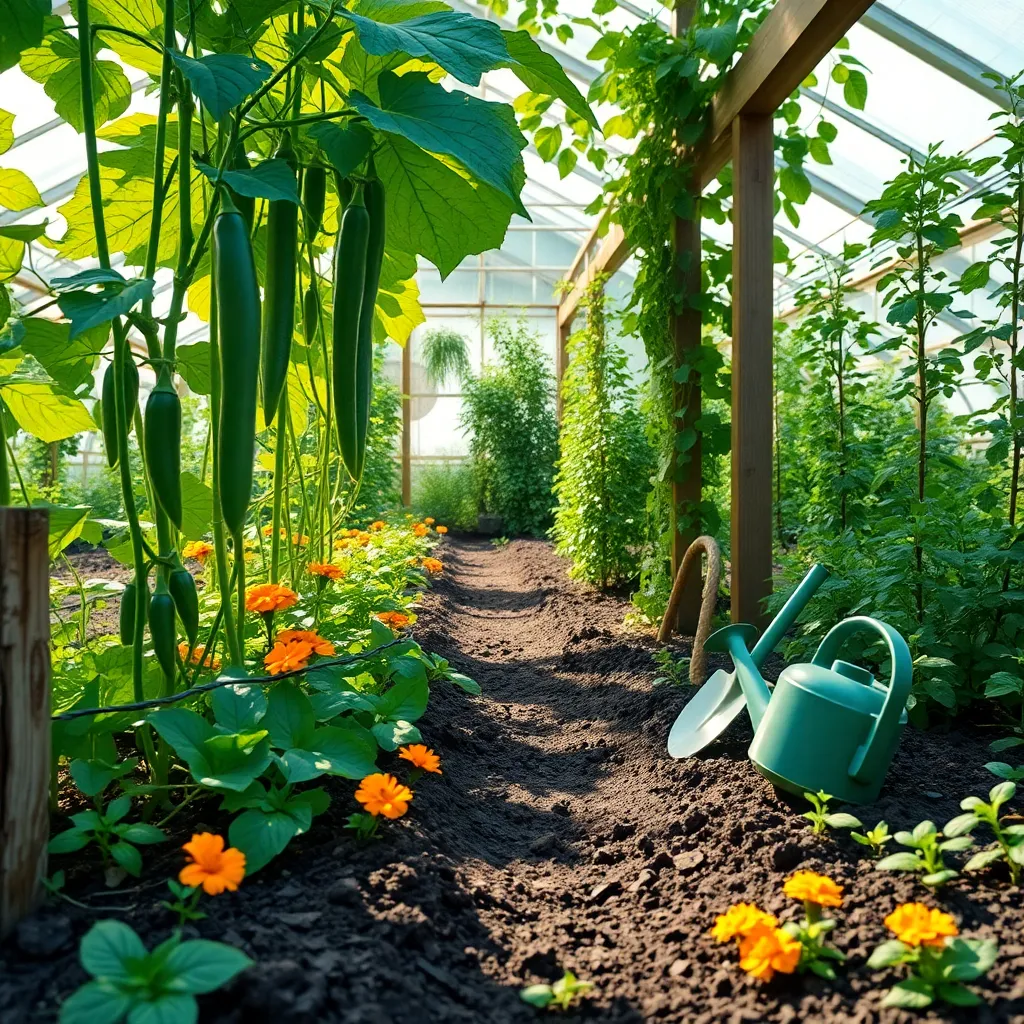
Rotating crops seasonally within your garden can significantly enhance both soil health and plant productivity. By changing the location of your climbing plants each season, you help prevent soil-borne diseases and reduce pest infestations.
One practical tip is to follow the principle of crop rotation by plant family. For instance, if you grew beans or peas on a trellis this year, consider planting cucumbers or squash in that spot next year. This rotation helps maintain a balanced nutrient profile in the soil, as different plant families have varying nutrient needs.
To maximize the benefits of crop rotation, consider soil amendment and trellis placement. Add organic compost to your soil before planting to replenish nutrients and improve soil structure. For optimal growth, ensure your trellis is positioned to provide sufficient sunlight and air circulation to your new crop.
Advanced gardeners might experiment with intercropping techniques, using trellises to support multiple plant types simultaneously. For example, try growing climbing beans with fast-growing leafy greens at the base. This technique can increase diversity and productivity in a limited space, providing a continual harvest throughout the growing season.
Conclusion: Growing Success with These Plants
In exploring ’12 Essential Trellis Ideas For Climbing Plants,’ we’ve uncovered a metaphorical guide to nurturing relationships with the same care we give to our gardens. From the importance of building a sturdy foundation to supporting growth through mutual understanding and creativity, each concept serves as a vital trellis for your relationship’s flourishing. We’ve discussed fostering communication, embracing flexibility, and celebrating individuality, as well as the power of shared goals and resilience in weathering life’s storms.
As an immediate next step, choose one concept to focus on this week—whether it’s enhancing communication or setting shared goals—and dedicate time to nurturing this aspect of your relationship. By taking small, consistent actions, you’ll build a sturdy framework for lasting love.
Remember, relationships grow and evolve, just like climbing plants reaching for the sun. Bookmark this article as your go-to guide for relationship maintenance, and revisit it whenever you need inspiration or a gentle reminder of the foundational principles at play. By cultivating these trellis concepts, you’re setting the stage for a relationship that not only survives but thrives amidst life’s ever-changing seasons. Let this be the beginning of your journey toward enduring relationship success.

